December marks the second month running where the installer-nominated ‘Solar Choice Discount’ has been excluded from our calculations, resulting in pricing more reflective of actual retail commercial solar system prices available through installers in Solar Choice’s network. The overall result is apparently lower average prices for solar systems sized 10kW, 30kW, 50kW and 100kW. Regardless of the change in calculation method, a downwards price trend has been observable since winter of this year.
Also different in this month’s figures is the renewed inclusion of prices for Tasmania, which had been excluded since July of this year due to the small number of installers in our network quoting prices for commercial systems.
Commercial solar system prices (10kW-100kW)
All prices in the tables below are include incentives available through the federal Renewable Energy Target as well as GST.
Table 1: Commercial solar PV system prices for December 2015 (average)
Table 2: $/W commercial solar PV system prices for December 2015 (average)
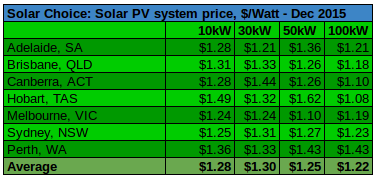 Historic pricing for popular commercial solar system sizes
Historic pricing for popular commercial solar system sizes
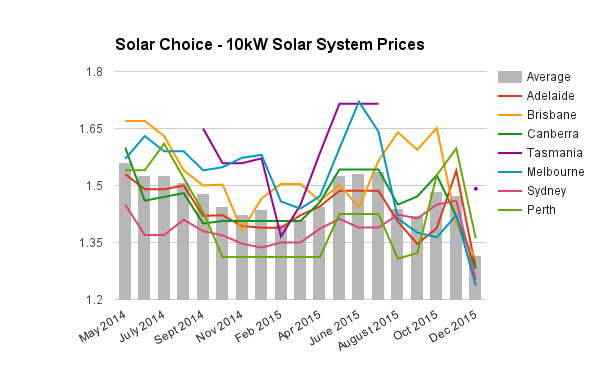
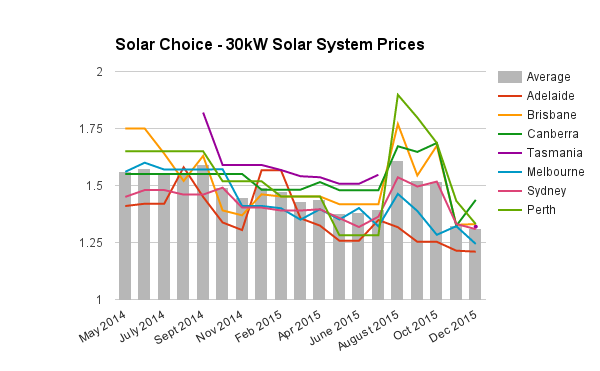
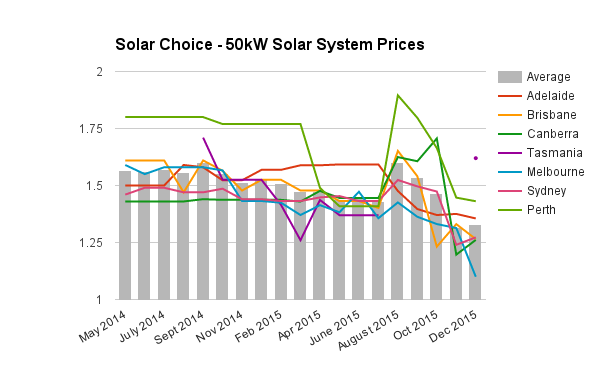
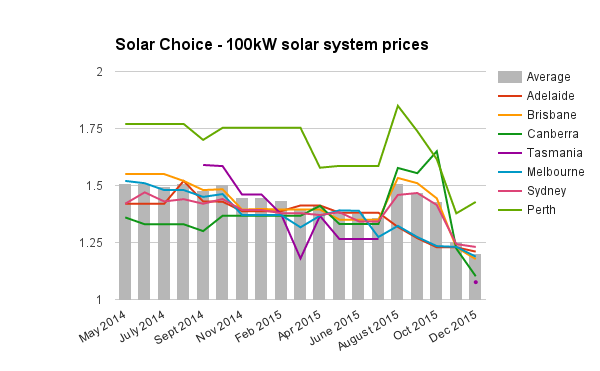 Commercial system prices – All system sizes
Commercial system prices – All system sizes
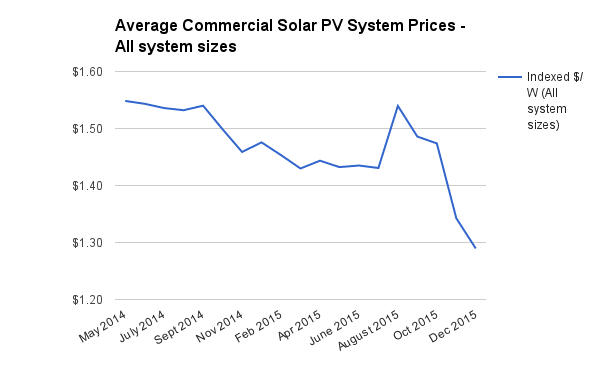 About this data
About this data
Tables and charts included in this article were compiled using data from Solar Choice’s installer network database, which contains regularly-updated pricing and product details from over 100 solar installation companies across Australia. Although all pricing calculations do account for federal incentives and GST, they do not incorporate meter installation fees or additional costs, such as ground-mounting or grid connection studies. ‘Premium’ installer offerings are not included in the calculations.
© 2015 Solar Choice Pty Ltd
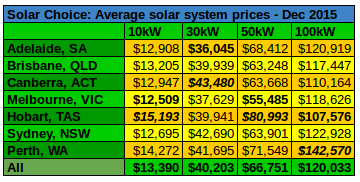
this data is interesting in that it does not show much in the way of economy of scale. Taking Sydney as an example the unit cost difference between a 10 KW and 100 KW system is less than 2%. The data is helpful in thinking about distributed v utilty scale solar.
Hi David,
We do have a larger sample size (more installer data) for 10kW solar systems, which could explain the difference. Some other readers of ours have speculated that the apparent lack of economies of scale could be due the cost of grid studies, but installers in our network are not required to include network/grid study costs in their indicative quotes, as they may not be necessary for all projects.
I should emphasise that data in these articles is based only on the pricing of installers in the Solar Choice network. While this does make it a fairly representative sample, it’s by no means complete (there are thousands of installers in Australia), and we have a larger number of installers posting prices for residential system sizes (up to 10kW) than we do for commercial system sizes (10kW+). You will still notice, however, that you can see the average $/W price for systems 30kW, 50kW and 100kW has an inverse relationship with system size – evidence of some economy of scale dynamics in action.
Being able to see the absolute highs and lows for each system size might shed some light on the matter as well, but we do not publish this data for commercial sizes at the moment.
Hope this helps.
Hi, I just want to ask does the price data for commercial buildings include the cost of using cranes for those that are really tall?
And for the average price in Sydney, 10kW is $1.25/W but 30kW is $1.31/W. Is there a reason for the increase is price per watt even the system is larger? Thanks for your help!
Hi Jacky,
The prices included in this article are for basic rooftop installations and would not include the cost of things like cranes or ground-mounting equipment. Although these prices would apply in many situations, they are indicative only and do not apply in situations where extra works like these would be necessary.
The increase in price for 30kW systems vs 10kW is due mainly to the fact that networks generally begin to require grid studies and export control devices once systems get larger than around 10kW (smaller in some places). The ‘hump’ that you see with 30kW systems – which are on the smaller end of the commercial solar scale – is likely due to this fact. These costs get normalised when the systems get larger, however, hence explaining why 50kW and 100kW systems tend to have lower $/W indicative prices.
Hope this helps! Thanks for your interest!
Is there any chance in recalculating the entire data set to exclude the discount? Otherwise all the data before November is meaningless and actually misleading.
Hi Ruben,
The difference isn’t vast (only a few cents per watt) so decided that it was okay to print the numbers as-is. We will look into updating the charts in the next edition to reflect the change, but don’t expect it to make a dramatic difference.